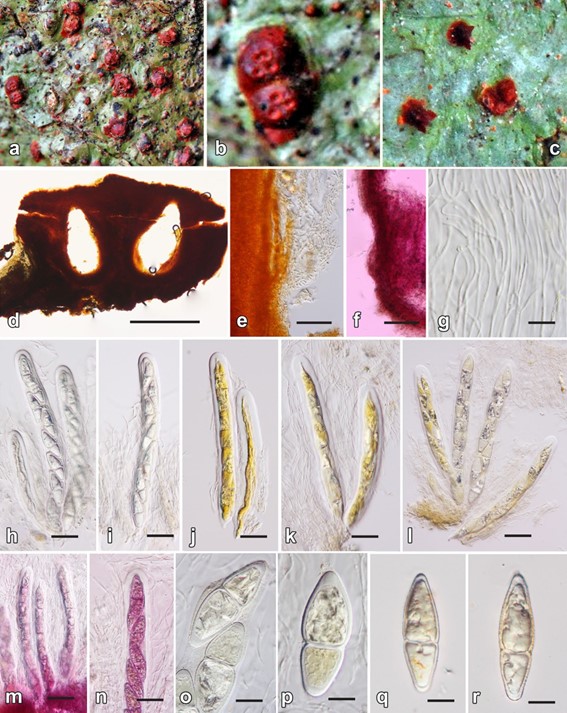Trypetheliopsis boninensis Asahina, J. Jap. Bot. 13(5): 319 (1937).
MycoBank number: MB 411966; Index Fungorum number: IF 411966; Facesoffungi number: FoF 08086; Fig. 53.
Lichenized on bark in tropical regions. Thallus corticate, olive-green. Photobiont Trentepohlia. Ascomata pseudostromatic, prominent, with orange-red pigment, ostiolate, ostiole apical. Involucrellum present, carbonized. Excipulum dense, consisting of compressed hyphae, appearing prosoplectenchymatous in thin, bleached sections, brown. Hamathecium comprising 0.5–0.7 µm wide paraphyses, hyaline, straight, branched and anastomosing, usually inspersed. Asci 8-spored. Ascospores irregularly arranged, oval-oblong, fusifurm, 1-septate, with constrictions at septum, 40–50 × 15–20 µm, with internal, needle-shaped crystals. Conidiomata of two type, pycnidia and campylidiiform, with orange-red pigment. Conidia acrogenous, aseptate, drop-shaped, small, hyaline, aggregated in gelatinous mass.
Chemistry: Several orange-red pigments, identified as skyrin, oxyskyrin and skyrinol (Santesson 1970).
Material examined: JAPAN, Ryukyu, Pref. Okinawa, Iriomote-jima, around Kanpirei Fall, Taketomi-cho, Yaeyamagun, 24°21’17″ N, 123°48’29″ E, alt. c. 70 m, on bark, 9 March 2018, Kashiwadani 52239 & Moon, TNS).
Notes: We were able to restudy the type and other material in detail (Fig. 53). The ascomata are pseudostromatic, with 5–10 perithecia per pseudostroma, rather closely resembling the pseudostromata of Trypethelium sensu stricto (Aptroot and Lücking 2016). The ascospores are distinctly fusiform with a marked submedian septum, resembling those of certain Megalotremis species. Recently collected material (Kashiwadani 52239 & Moon, TNS) shows two types of conidiomata: red pycnidia and dark red campylidia (Fig. 53). Trypetheliopsis boninensis is thus clearly congeneric with Musaespora and differs from the type of the latter, M. corticola (= T. gigas) largely in the sessile vs. prominent, strongly pigmented ascomata. The close relationship between these taxa is also illustrated by T. coccinea, which features a similar pigment as T. boninensis and differs from the latter in the foliicolous growth habit, distinctly verrucose thallus and erumpent to prominent, solitary ascomata.

Fig. 53 Morphology, asci and ascospores in Trypetheliopsis boninensis. a–c Thallus with ascomata, pycnidia, and campylidia (Japan, Kashiwadani 52239 & Moon). d–r Hamathecium, asci, and ascospores (holotype). Scale bars: d = 0.5 µm, e, f, h–n = 40 µm, g, o–r = 10 µm
Species
